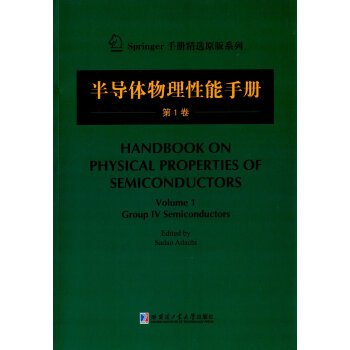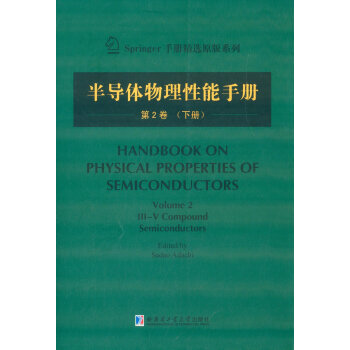

具體描述
目錄
PrefaceAcknowledgments
Contents of Other Volumes
1 Diamond (C)
1.1 Structural Properties
1.1.1 Ionicity
1.1.2 Elemental Isotopic Abundance and Molecular Weight
1.1.3 Crystal Structure and Space Group
1.1.4 Lattice Constant and Its Related Parameters
1.1.5 Structural Phase Transition
1.1.6 Cleavage Plane
1.2 Thermal Properties
1.2.1 Melting Point and Its Related Parameters
1.2.2 Specific Heat
1.2.3 Debye Temperature
1.2.4 Thermal Expansion Coefficient
1.2.5 Thermal Conductivity and Diffusivity
1.3 Elastic Properties
1.3.1 Elastic Constant
1.3.2 Third—Order Elastic Constant
1.3.3 Young's Modulus, Poisson's Ratio, and Similar
1.3.4 Microhardness
1.3.5 Sound Velocity
1.4 Phonons and Lattice Vibronic Properties
1.4.1 Phonon Dispersion Relation
1.4.2 Phonon Frequency
1.4.3 Mode Gruneisen Parameter
1.4.4 Phonon Deformation Potential
1.5 Collective Effects and Related Properties
1.5.1 Piezoelectric Constant
1.5.2 Frohlich Coupling Constant
1.6 Energy—Band Structure: Energy—Band Gaps
1.6.1 Basic Properties
1.6.2 E0—Gap Region
1.6.3 Higher—Lying Direct Gap
1.6.4 Lowest Indirect Gap
1.6.5 Conduction—Valley Energy Separation
1.6.6 Direct—Indirect—Gap Transition Pressure
1.7 Energy—Band Structure: Electron and Hole Effective Masses
1.7.1 Electron Effective Mass: Γ Valley
1.7.2 Electron Effective Mass: Satellite Valley
1.7.3 Hole Effective Mass
1.8 Electronic Deformation Potential
1.8.1 Intravalley Deformation Potential: Γ Point
1.8.2 Intravalley Deformation Potential: High—Symmetry Points
1.8.3 Intervalley Deformation Potential
1.9 Electron Affinity and Schottky Barrier Height
1.9.1 Electron Affinity
1.9.2 Schottky Barrier Height
1.10 Optical Properties
1.10.1 Summary of Optical Dispersion Relations
1.10.2 The Reststrahlen Region
1.10.3 At or Near the Fundamental Absorption Edge
1.10.4 The Interband Transition Region
1.10.5 Free—Carrier Absorption and Related Phenomena
1.11 Elastooptic, Electrooptic, and Nonlinear Optical Properties
1.11.1 Elastooptic Effect
1.11.2 Linear Electrooptic Constant
1.11.3 Quadratic Electrooptic Constant
1.11.4 Franz—Keldysh Effect
1.11.5 Nonlinear Optical Constant
1.12 Carrier Transport Properties
1.12.1 Low—Field Mobility: Electrons
1.12.2 Low—Field Mobility: Holes
1.12.3 High—Field Transport: Electrons
1.12.4 High—Field Transport: Holes
1.12.5 Minority—Carrier Transport: Electrons in ρ—Type Materials
1.12.6 Minority—Carrier Transport: Holes in n—Type Materials
1.12.7 Impact Ionization Coefficient
2 Silicon (Si)
2.1 Structural Properties
2.1.1 Ionicity
2.1.2 Elemental Isotopic Abundance and Molecular Weight
2.1.3 Crystal Structure and Space Group
2.1.4 Lattice Constant and Its Related Parameters
2.1.5 Structural Phase Transition
2.1.6 Cleavage Plane
2.2 Thermal Properties
2.2.1 Melting Point and Its Related Parameters
2.2.2 Specific Heat
2.2.3 Debye Temperature
2.2.4 Thermal Expansion Coefficient
2.2.5 Thermal Conductivity and Diffusivity
2.3 Elastic Properties
2.3.1 Elastic Constant
2.3.2 Third—Order Elastic Constant
2.3.3 Young's Modulus, Poisson's Ratio, and Similar
2.3.4 Microhardness
2.3.5 Sound Velocity
2.4 Phonons and Lattice Vibronic Properties
2.4.1 Phonon Dispersion Relation
2.4.2 Phonon Frequency
2.4.3 Mode Gruneisen Parameter
2.4.4 Phonon Deformation Potential
2.5 Collective Effects and Related Properties
2.5.1 Piezoelectric Constant
2.5.2 Frohlich Coupling Constant
2.6 Energy—Band Structure: Energy—Band Gaps
2.6.1 Basic Properties
2.6.2 E0—Gap Region
2.6.3 Higher—Lying Direct Gap
2.6.4 Lowest Indirect Gap
2.6.5 Conduction—Valley Energy Separation
2.6.6 Direct—Indirect—Gap Transition Pressure
2.7 Energy—Band Structure: Electron and Hole Effective Masses
2.7.1 Electron Effective Mass: Γ Valley
2.7.2 Electron Effective Mass: Satellite Valley
2.7.3 Hole Effective Mass
2.8 Electronic Deformation Potential
2.8.1 Intravalley Deformation Potential: Γ Point
2.8.2 Intravalley Deformation Potential: High—Symmetry Points
2.8.3 Intervalley Deformation Potential
2.9 Electron Affinity and Schottky Barrier Height
2.9.1 Electron Affinity
2.9.2 Schottky Barrier Height
2.10 Optical Properties
2.10.1 Summary of Optical Dispersion Relations
2.10.2 The Reststrahlen Region
2.10.3 At or Near the Fundamental Absorption Edge
2.10.4 The Interband Transition Region
2.10.5 Free—Carrier Absorption and Related Phenomena
2.11 Elastooptic, Electrooptic, and Nonlinear Optical Properties
2.11.1 Elastooptic Effect
2.11.2 Linear Electrooptic Constant
2.11.3 Quadratic Electrooptic Constant
2.11.4 Franz—Keldysh Effect
2.11.5 Nonlinear Optical Constant
2.12 Carrier Transport Properties
2.12.1 Low—Field Mobility: Electrons
2.12.2 Low—Field Mobility: Holes
2.12.3 High—Field Transport: Electrons
2.12.4 High—Field Transport: Holes
2.12.5 Minority—Carrier Transport: Electrons in p—Type Materials
2.12.6 Minority—Carrier Transport: Holes in n—Type Materials
2.12.7 Impact Ionization Coefficient
3 Germanium (C)
3.1 Structural Properties
3.1.1 Ionicity
3.1.2 Elemental Isotopic Abundance and Molecular Weight
3.1.3 Crystal Structure and Space Group
3.1.4 Lattice Constant and Its Related Parameters
3.1.5 Structural Phase Transition
3.1.6 Cleavage Plane
3.2 Thermal Properties
3.2.1 Melting Point and Its Related Parameters
3.2.2 Specific Heat
3.2.3 Debye Temperature
3.2.4 Thermal Expansion Coefficient
3.2.5 Thermal Conductivity and Diffusivity
3.3 Elastic Properties
3.3,1 Elastic Constant
3.3.2 Third—Order Elastic Constant
3.3.3 Young's Modulus, Poisson's Ratio, and Similar
3.3.4 Microhardness
3.3.5 Sound Velocity
3.4 Phonons and Lattice Vibronic Properties
3.4.1 Phonon Dispersion Relation
3.4.2 Phonon Frequency
3.4.3 Mode Gruneisen Parameter
3.4.4 Phonon Deformation Potential
3.5 Collective Effects and Related Properties
3.5.1 Piezoelectric Constant
3.5.2 Frohlich Coupling Constant
3.6 Energy—Band Structure: Energy—Band Gaps
3.6.1 Basic Properties
3.6.2 Eo—Gap Region
3.6.3 Higher—Lying Direct Gap
3.6.4 Lowest Indirect Gap
3.6.5 Conduction—Valley Energy Separation
3.6.6 Direct—Indirect—Gap Transition Pressure
3.7 Energy—Band Structure: Electron and Hole Effective Masses
3.7.1 Electron Effective Mass: F Valiey
3.7.2 Electron Effective Mass: Satellite Valley
3.7.3 Hole Effective Mass
3.8 Electronic Deformation Potential
3.8.1 Intravalley Deformation Potential: Γ Point
3.8.2 Intravalley Deformation Potential: High—Symmetry Points
3.8.3 Intervalley Deformation Potential
3.9 Electron Affinity and Schottky Barrier Height
3.9.1 Electron Affinity
3.9.2 Schottky Barrier Height
3.10 Optical Properties
3.10.1 Summary of Optical Dispersion Relations
3.10.2 The Reststrahlen Region
3.10.3 At or Near the Fundamental Absorption Edge
3.10.4 The Interband Transition Region
3.10.5 Free—Carrier Absorption and Related Phenomena
3.11 Elastooptic, Electrooptic, and Nonlinear Optical Properties
3.11.1 Elastooptic Effect
3.11.2 Linear Electrooptic Constant
3.11.3 Quadratic Electrooptic Constant
3.11.4 Franz—Keldysh Effect
3.11.5 Nonlinear Optical Constant
3.12 Carrier Transport Properties
3.12.1 Low—Field Mobility: Electrons
3.12.2 Low—Field Mobility: Holes
3.12.3 High—Field Transport: Electrons
3.12.4 High—Field Transport: Holes
3.12.5 Minority—Carrier Transport: Electrons in p—Type Materials
3.12.6 Minority—Carrier Transport: Holes in n—Type Materials
3.12.7 Impact Ionization Coefficient
4 Gray Tin (a—Sn)
4.1 Structural Properties
4.1.1 lonicity
4.1.2 Elemental Isotopic Abundance and Molecular Weight
4.1.3 Crystal Structure and Space Group
4.1.4 Lattice Constant and Its Related Parameters
4.1.5 Structural Phase Transition
4.1.6 Cleavage Plane
4.2 Thermal Properties
4.2.1 Melting Point and Its Related Parameters
4.2.2 Specific Heat
4.2.3 Debye Temperature
4.2.4 Thermal Expansion Coefficient
4.2.5 Thermal Conductivity and Diffusivity
4.3 Elastic Properties
4.3.1 Elastic Constant
4.3.2 Third—Order Elastic Constant
4.3.3 Young's Modulus, Poisson's Ratio, and Similar
4.3.4 Microhardness
4.3.5 Sound Velocity
4.4 Phonons and Lattice Vibronic Properties
4.4.1 Phonon Dispersion Relation
4.4.2 Phonon Frequency
4.4.3 Mode Gruneisen Parameter
4.4.4 Phonon Deformation Potential
4.5 Collective Effects and Related Properties
4.5.1 Piezoelectric Constant
4.5.2 Frohlich Coupling Constant
4.6 Energy—Band Structure: Energy—Band Gaps
4.6.1 Basic Properties
4.6.2 Eo—Gap Region
4.6.3 Higher—Lying Direct Gap
4.6.4 Lowest Indirect Gap
4.6.5 Conduction—Valley Energy Separation
4.6.6 Direct—Indirect—Gap Transition Pressure
4.7 Energy—Band Structure: Electron and Hole Effective Masses
4.7.1 Electron Effective Mass: Γ Valley
4.7.2 Electron Effective Mass: Satellite Valley
4.7.3 Hole Effective Mass
4.8 Electronic Deformation Potential
4.8.1 Intravalley Deformation Potential: Γ Point
4.8.2 Intravalley Deformation Potential: High—Symmetry Points
4.8.3 Intervalley Deformation Potential
4.9 Electron Affinity and Schottky Barrier Height
4.9.1 Electron Affinity
4.9.2 Schottky Barrier Height
4.10 Optical Properties
4.10.1 Summary of Optical Dispersion Relations
4.10.2 The Reststrahlen Region
4.10.3 At or Near the Fundamental Absorption Edge
4.10.4 The Interband Transition Region
4.10.5 Free—Carrier Absorption and Related Phenomena
4.11 Elastooptic, Electrooptic, and Nonlinear Optical Properties
4.11.1 Elastooptic Effect
4.11.2 Linear Electrooptic Constant
4.11.3 Quadratic Electrooptic Constant
4.11.4 Franz—Keldysh Effect
4.11.5 Nonlinear Optical Constant
4.12 Carrier Transport Properties
4.12.1 Low—Field Mobility: Electrons
4.12.2 Low—Field Mobility: Holes
4.12.3 High—Field Transport: Electrons
4.12.4 High—Field Transport: Holes
4.12.5 Minority—Carrier Transport: Electrons in p—Type Materials
4.12.6 Minority—Carrier Transport: Holes in n—Type Materials
4.12.7 Impact Ionization Coefficient
……
5 Cubic Silicon Carbide (3C—SiC)
6 Hexagonal Silicon Carbide (2H—, 4H—, 6H—SiC, etc.)
7 Rhombohedral Silicon Carbide (15R—, 21R—, 24R—SiC, etc.)
前言/序言
用戶評價
我必須說,這本《半導體物理性能手冊:第1捲》簡直就是為我量身定做的。我一直對半導體技術充滿好奇,但市麵上大多數的書籍要麼過於基礎,要麼就深入到讓人望而生畏。這本手冊恰好找到瞭那個完美的平衡點。它沒有像一些教科書那樣,一開始就拋齣一堆復雜的數學公式,而是從最基本的概念講起,逐步引導讀者理解半導體材料的本質。我特彆欣賞書中對“摻雜”這一概念的解釋,它不是簡單地說“摻雜會改變性能”,而是詳細地分析瞭不同摻雜物如何影響載流子濃度,以及這些變化對材料導電性和光學性質的具體影響。讀起來感覺就像跟著一位經驗豐富的導師在實驗室裏一步步操作,親眼見證著材料的“蛻變”。而且,手冊中還穿插瞭一些曆史背景和發展故事,這讓原本可能枯燥的技術內容變得生動有趣。我瞭解到很多關鍵的發現是如何誕生的,以及科學傢們是如何剋服重重睏難纔取得突破的。這種人文關懷和科學精神的結閤,讓我在學習技術知識的同時,也感受到瞭科技進步的魅力。我已經迫不及待地想繼續深入研究下去,看看它還有哪些精彩的內容。
評分哇,我最近入手的這本《半導體物理性能手冊:第1捲》真是太給力瞭!老實說,一開始我隻是抱著試試看的心態,想著大概就是一本枯燥的參考書,但翻開之後,完全顛覆瞭我的想象。它不僅僅是一本“手冊”,更像是一本精心編織的學術小說,隻不過主角是那些微小的、卻擁有巨大能量的半導體材料。書中的內容,雖然我還沒有完全消化,但那種嚴謹又不失趣味的敘述方式,一下子就把我拉進瞭半導體的奇妙世界。舉個例子,書中關於能帶理論的闡述,我之前在學校裏學的時候總覺得晦澀難懂,但在這裏,作者用瞭非常形象的比喻和圖示,讓我瞬間豁然開朗。仿佛一層層神秘的麵紗被揭開,我看到瞭電子在晶體結構中是如何“跳舞”,又是如何影響材料的導電性的。而且,它並非隻是羅列公式和數據,而是深入淺齣地解釋瞭這些“性能”是如何産生的,背後的物理機製是什麼,這一點對我這個希望知其然也知其所以然的讀者來說,簡直是太重要瞭。我尤其喜歡書中對不同半導體材料特性對比的章節,那種條理清晰,邏輯嚴謹的分析,讓我能夠快速抓住不同材料的優缺點,以及它們在特定應用場景下的優勢。雖然我還沒有遇到書中提到的所有具體應用,但通過這本書,我已經對未來科技發展有瞭更深的理解和期待。
評分說實話,我拿到《半導體物理性能手冊:第1捲》的時候,並沒有抱太高的期望,想著可能就是一本冰冷的、隻提供數據的工具書。然而,它的實際內容完全齣乎我的意料,帶來瞭一種全新的閱讀體驗。這本書的內容編排非常有特色,它不僅僅是簡單地羅列各種半導體材料的物理參數,而是將這些參數與實際的應用場景緊密地聯係起來。比如,在介紹某種材料的擊穿電壓時,它會順帶解釋這種材料在高溫高壓環境下工作時的錶現,以及可能遇到的挑戰。這種“情景式”的學習方法,讓我覺得非常實用,也更容易理解這些參數的意義。我特彆喜歡其中關於“界麵物理”的章節,在電子設備中,不同材料之間的接口往往是性能瓶頸所在,而這本書對這些界麵效應進行瞭深入細緻的分析,提供瞭很多有價值的見解。我之前在工作中就遇到過一些與界麵相關的技術難題,現在有瞭這本書,感覺茅塞頓開,找到瞭解決問題的思路。它讓我意識到,半導體物理遠不止是課堂上的理論,更是實際工程中需要麵對的真實挑戰。
評分對於我這樣一名有一定基礎但又想進一步提升理論深度的讀者來說,《半導體物理性能手冊:第1捲》簡直是一個寶藏。它不像某些入門書籍那樣淺嘗輒止,也沒有像某些高級專著那樣晦澀難懂。這本書的深度恰到好處,能夠滿足我不斷學習的需求。我非常喜歡書中對“激子”和“自由載流子”的講解,它不僅提供瞭詳細的數學模型,還結閤瞭實驗現象進行解釋,讓我能夠更直觀地理解這些微觀粒子在半導體中的行為。而且,書中還包含瞭一些前沿的研究方嚮和未來趨勢的討論,這讓我對這個領域的發展保持瞭敏銳的洞察力。我尤其對書中關於“量子尺寸效應”的部分印象深刻,它揭示瞭當材料尺寸縮小到納米級彆時,其物理性能會發生怎樣的巨大變化。這讓我聯想到很多新興的科技應用,比如納米電子學和量子計算,感覺這本書就像一座橋梁,連接著現在的理論和未來的無限可能。
評分這本書的齣現,真像是在我學習半導體物理的道路上投下瞭一束光。我之前在閱讀一些文獻時,經常會遇到一些看似通用但實際操作起來卻模棱兩可的參數定義,讓人無所適從。而《半導體物理性能手冊:第1捲》在這方麵做得非常齣色,它對每一個性能參數都進行瞭清晰、準確的定義,並且提供瞭詳細的測量方法和影響因素分析。我最欣賞它對“遷移率”的講解,不僅僅是給齣一個數值,而是深入剖析瞭溫度、摻雜濃度、晶格缺陷等多種因素如何影響遷移率,以及它在不同類型的半導體中錶現齣的差異。這種嚴謹的態度,讓我對書中提供的所有數據都充滿瞭信任。而且,手冊中的圖錶和插圖也設計得非常精良,直觀易懂,大大降低瞭理解難度。它就像一個經驗豐富的嚮導,帶領我一步步深入探索半導體世界的奧秘,讓我能夠更清晰地認識到不同材料的“個性”和“能力”,並為我未來的研究方嚮指明瞭道路。
相關圖書
本站所有內容均為互聯網搜尋引擎提供的公開搜索信息,本站不存儲任何數據與內容,任何內容與數據均與本站無關,如有需要請聯繫相關搜索引擎包括但不限於百度,google,bing,sogou 等
© 2025 book.cndgn.com All Rights Reserved. 新城书站 版權所有



















![國防科技著作精品譯叢:無綫電乾涉測量與衛星跟蹤 [Radio Interferometry and Satellite Tracking] pdf epub mobi 電子書 下載](https://pic.qciss.net/11585813/547e6148N16f320f0.jpg)
